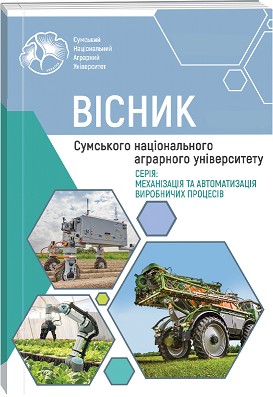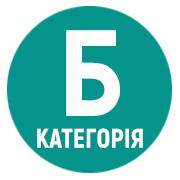IMPROVEMENT OF LEGUME DISHES FOR SCHOOL MEALS AND PROSPECTS FOR THEIR INTRODUCTION INTO SCHOOL MENUS
Abstract
Studies of the organization of school meals in Ukraine revealed a number of significant problems that became the basis for the global reform of the school meal system in 2020. Today, the improvement of the school nutrition system in Ukraine is aimed at fostering culture and correct eating habits, strengthening health, harmonious physiological development of the child and is carried out in accordance with the National Strategy for the development of a safe and healthy educational environment in the New Ukrainian School. This becomes possible thanks to an integrated approach in this area, which takes into account medical, legal, social, financial and technological aspects. However, the gradual implementation of the reform showed that dissatisfaction with school meals of children and their parents still exists. This especially applies to the group of dishes from legumes, which, on the one hand, are an important component of the diet due to their high nutritional and biological value and must be included once a week in the school menu, and on the other hand, are the least popular among schoolchildren. According to our observations, the problem of refusal of schoolchildren to consume dishes made from legumes and the related loss of finished products up to 92% in the form of food waste is of a systemic nature. Indirectly, this is confirmed by the discovered facts of the exclusion of legume dishes from the menus of various schools. According to the conducted anonymous voluntary surveys of students of all age groups, we found a tendency to decrease the desire to consume legume dishes from the new four-week menu with a decrease in the age of the children, as well as the regularity of their sharply negative reaction to these dishes due to the pronounced specific smell and taste of the main raw materials. Based on this, we have proposed new approaches in the preparation of dishes from legumes. They included the creation of culinary products with raw materials, organoleptic indicators, appearance, presentation, and brand name that would not have associations with legumes. The result of research and practice were two improved dishes – "Magic Falafel" and "Banana Fireworks", which received the highest rating during the tasting by schoolchildren. The first was falafel made from boiled chickpeas with the use of a wide range of spices and herbs, and the second was fritters made from beans with the addition of banana and dried apricots. A project of technological cards and a HACCP plan for introducing new dishes into the school menu were developed for the new dishes. Calculations of the expected economic effect proved that the introduction of improved meals will allow more effective use of state funding due to a reduction of losses by 75% per year from one school (on the example of KU SSSH I-III degrees №29, Sumy). At the same time, reducing the number of uneaten meals in the form of food waste by 3,390 kg per year will contribute to reducing the negative impact on the environment.
References
2. Batlle-Bayer, L., Bala, A., Aldaco, R., Vidal-Monés, B., Colomé, R., &Fullana-i-Palmer, P. (2021). Anexplorative assessment of environmental and nutritional benefits of introducing low–carbon meals to Barcelona schools. Science of The Total Environment, 756, 143879. https://doi.org/10.1016/j.scitotenv.2020.143879
3. Berzin, V. I., & Stelmakhivska, V. P. (2018). Hygienic aspects of the problem of school age children feeding in modern conditions.Health of Society,7(2), 87–90. https://doi.org/10.22141/2306-2436.7.2.2018.137733
4. Clubei, S., Pogorelova, K., Saltykova, H., Gnyloskurenko, G., &King, E. (2021). Exploration of factors of formation of food habits and modern tendencies of school food at children of different age. Ukrainian Scientific Medical Youth Journal, 121 (1), 70-82. https://doi.org/10.32345/usmyj.1(121).2021.70-82
5. Cohen, J. F. W., Richardson, S., Austin, S. B., Economos, C. D., &Rimm, E. B. (2013). School Lunch Waste Among Middle School Students. American Journal of Preventive Medicine, 44 (2), 114-121. https://doi.org/10.1016/j.amepre.2012.09.060
6. Halushko N. A. Evolution of nutrition system of the population of independent Ukraine. Ukrainian Journal of Modern Toxicological Aspects. 2018. Vol. 82-83, no. 2-3. P. 107–117. https://doi.org/10.33273/2663-4570-2018-82-83-2-3-107-117
7. Heiko, L., & Yurochko, T. (2020). Healthy diet policy for children of early school age in ukraine: literature review. Investytsiyi: praktyka ta dosvid, (15-16), 81. https://doi.org/10.32702/2306-6814.2020.15-16.81
8. Höijer, K., Lindö, C., Mustafa, A., Nyberg, M., Olsson, V., Rothenberg,E., Sepp, H., &Wendin, K. (2020). Health and Sustainability in Public Meals – An Explorative Review. International Journal of Environmental Research and Public Health, 17(2), 621. https://doi.org/10.3390/ijerph17020621
9. Hozak S. V., Yelizarova O. T., Stankevych T. V., &Parats A. M. (2017). Faktychne kharchuvannia suchasnykh shkoliriav ta yoho vplyv na rozumovu pratsezdatnist i vtomu [Factual nutrition of modern schoolchildren and its impact on mental efficiency and fatigue]. Dovkillia ta zdorovia, (3 (83)), 29-33. URL: https://cyberleninka.ru/article/n/faktichne-harchuvannyasuchasnih-shkoliryav-ta-yogo-vpliv-na-rozumovu-pratsezdatnist-i-vtomu (in Ukrainian)
10. Johnston, J. L., Fanzo, J. C., &Cogill, B. (2014). Understanding Sustainable Diets: A Descriptive Analysis of the Determinants and Processes That Influence Diets and Their Impact on Health, Food Security, and Environmental Sustainability. Advances in Nutrition, 5 (4), 418-429. https://doi.org/10.3945/an.113.005553
11. Katz, D.L., &Meller,S. (2014). Can We Say What Diet Is Best for Health? Annual Review of Public Health, 35 (1), 83-103. URL: https://doi.org/10.1146/annurev-publhealth-032013-182351
12. Malisova, O., Vlassopoulos, A., Kandyliari, A., Panagodimou, E., &Kapsokefalou, M. (2021). Dietary Intake and Lifestyle Habits of Children Aged 10-12 Years Enrolled in the School Lunch Program in Greece: A Cross Sectional Analysis. Nutrients, 13 (2), 493. https://doi.org/10.3390/nu13020493.
13. Martone, D., Roccaldo, R., Censi, L., Toti, E., Catasta, G., D’Addesa, D., Carletti, C., Censi, L., D’Addesa, D., D’Amicis, A., Angelini, V., Bevilacqua, N., Catasta, G., Fabbri, I., Galfo, M., Martone, D., Roccaldo, R., Toti, E., Spinelli, A., Spizzichino, L. (2013). Food consumption and nutrient in take in Italian schoolchildren: results of the ZOOM8 study. International Journal of Food Sciences and Nutrition, 64 (6), 700-705. https://doi.org/10.3109/09637486.2013.775226
14. Moreno, L., Sarría, A., &Popkin, B. (2002). The nutrition transition in Spain: a European Mediterranean country. European Journal of Clinical Nutrition, 56 (10), 992-1003. https://doi.org/10.1038/sj.ejcn.1601414
15. Pro zatverdzhennia Hihiienichnykh vymoh do vyrobnytstva ta obihu kharchovykh produktiv na potuzhnostiakh, roztashovanykh u zakladakh zahalnoi serednoi osvity, Nakaz Ministerstva rozvytku ekonomiky, torhivli ta silskoho hospodarstva Ukrainy № 2532 (2021) [On the approval of Hygienic requirements for the production and circulation of food products at facilities located in general secondary education institutions, Order of the Ministry of Economic Development, Trade and Agriculture of Ukraine No. 2532] URL: https://zakon.rada.gov.ua/laws/show/z1275-20#Text (in Ukrainian).
16. Pro zatverdzhennia norm ta Poriadku orhanizatsii kharchuvannia u zakladakh osvity ta dytiachykh zakladakh ozdorovlennia ta vidpochynku, Postanova Kabinetu Ministriv Ukrainy № 305 (2023) [On the approval of norms and the Procedure for the organization of meals in educational institutions and children's health and recreation institutions, Resolution of the Cabinet of Ministers of Ukraine No. 305] URL: https://zakon.rada.gov.ua/laws/show/305-2021-п#Text (in Ukrainian).
17. Pro zatverdzhennia Sanitarnoho rehlamentu dlia zakladiv zahalnoi serednoi osvity, Nakaz Ministerstva okhorony zdorovia Ukrainy № 2205 (2022) [On the approval of the Sanitary Regulations for general secondary education institutions, Order of the Ministry of Health of Ukraine No. 2205]. URL: https://zakon.rada.gov.ua/laws/show/z1111-20#Text (in Ukrainian).
18. Pryadko, O., Butenko, A., & Tkachuk, V. (2021). Analiz ratsionu shkilnoho kharchuvannia [Analysis of the nutritional value of school food]. Tovaroznavchyi visnyk, 1(14), 58–64. https://doi.org/10.36910/6775-2310-5283-2021-14-6(in Ukrainian)
19. Reforma shkilnoho kharchuvannia: rozbyraiemo osnovni zminy – Nakypilo. [Reform of school nutritions: we analyze the main changes]. URL: https://nakipelo.ua/ru/foodschool (in Ukrainian)
20. Rezultaty opytuvannia: zadovolenist batkiv ta uchniv shkilnym kharchuvanniam [Pres-reliz]. (2020). [Survey results: parents' and schoolchildren's satisfaction with school nutrition] Ministerstvo osvity i nauky Ukrainy. URL: https://mon.gov.ua/storage/app/media/zagalna%20serednya/2020/09/14/Rezultaty%20opytuvannya%20KHARCHUVANNYAM.pdf (in Ukrainian)
21. Ribal, J., Fenollosa, M. L., García-Segovia, P., Clemente, G., Escobar, N., &Sanjuán, N. (2015). Designing healthy, climate friendly and affordable school lunches. The International Journal of Life Cycle Assessment, 21 (5), 631-645. https://doi.org/10.1007/s11367-015-0905-8.
22. Rojas, A., Valley, W., Mansfield, B., Orrego, E., Chapman, G. E., & Harlap, Y. (2011). Toward Food System Sustainability through School Food System Change: Think &Eat Green@Schooland the Making of a Community-University Research Alliance. Sustainability, 3 (5), 763-788. https://doi.org/10.3390/su3050763
23. Rossi, L., Ferrari, M., Martone, D., Benvenuti, L., De Santis, A. (2021). The Promotions of Sustainable Lunch Meals in School Feeding Programs: The Case of Italy. Nutrients, 13 (5), 1-3. https://doi.org/10.3390/nu13051571
24. Rozpochala robotu platforma pro zdorove kharchuvannia u shkolakh «Znaimo» [Pres-reliz]. (2021). [The platform on healthy eating in schools «Znaimo» has started work] Ministerstvo osvity i nauky Ukrainy. URL: https://mon.gov.ua/ua/news/rozpochala-robotu-platforma-pro-zdorove-harchuvannya-u-shkolah-znayimo (in Ukrainian)
25. Sánchez-Villegas, A., Bes-Rastrollo, M., Martínez-González, M. A., &Serra-Majem, L. (2005). Adherenceto a Mediterrane аn dietary pattern and weight gainin a follow-upstudy: the SUN cohort. International Journal of Obesity, 30 (2), 350-358. https://doi.org/10.1038/sj.ijo.0803118
26. Skapa, T. V. (2021). Pryntsypovi zminy, shcho zaprovadzhuie reforma kharchuvannia [Pres-reliz] [Fundamental changes that introduces the nutritional reform]. Ministerstvo okhorony zdorovia Ukrainy. URL: https://mon.gov.ua/storage/app/media/news/2021/23.04/Pryntsypovi%20zminy_shcho%20zaprovadzhuye%20reforma%20kharchuvannya_Tetyana%20Skapa.pdf (in Ukrainian)
27. Skurykhyn, Y. M., & Volharev, M. N. (Red.). (1987). Khymycheskyi sostav pyshchevykh produktov: Kn. 1. Spravochnye tablytsy soderzhanyia osnovnykh pyshchevykh veshchestv y enerhetycheskoi tsennosty pyshchevykh produktov, 2-e yzd., pererab. y dop. [Chemical composition of food products: Book. 2. Reference tables for the content of basic nutrients and energy value of food products]. Moscow: Ahropromyzdat.
28. Smith, S. L., & Cunningham-Sabo, L. (2013). Food choice, plate waste and nutrient in take of elementary- andmiddleschool students participating in the US National School Lunch Program. Public Health Nutrition, 17 (6), 1255-1263. https://doi.org/10.1017/s1368980013001894.
29. Sobko, A., & Peresichna, S. (2022). Elaborating and Implementing Scientifically Reasonable School Breakfasts. Restaurant and hotel consulting. Innovations, 5 (1), 110-130. https://doi.org/10.31866/2616-7468.5.1.2022.260885.
30. Svystun T. V., Lianna A. S. (2017). Doslidzhennia rynku hromadskoho kharchuvannia ukrainy na prykladi orhanizatsii kharchuvannia shkoliariv [Study catering market of Ukraine on the example of the organization of school nutrition]. Food Industry Economics. T. 9, № 1. https://doi.org/10.15673/fie.v9i1.482(in Ukrainian)
31. Tekhnolohichni karty strav ta vyrobiv dlia kharchuvannia ditei vikom vid 6 do 18 rokiv u zakladakh osvity, dytiachykh zakladakh ozdorovlennia ta vidpochynku ta dytiachykh zakladakh sfery sotsialnoho zakhystu (Naukovyi zvit sanitarnoepidemiolohichnoi otsinky proiektu tekhnolohichnoi dokumentatsii № 8.2/2469 vid 06.09.2021 r.) [Technological maps of dishes and products for the nutrition of children aged 6 to 18 years in educational institutions, children's rehabilitation and recreation institutions, and children's institutions in the field of social protection (scientific report of the sanitaryepidemiological assessment of the technological documentation project No. 8.2/2469 dated 09/06/2021)]. (2021).
Derzhavna ustanova "Instytut hromadskoho zdorovia im. O.M.Marzeieva AMN Ukrainy". URL: https://znaimo.gov.ua/media/tehc/%D0%A2%D0%B5%D1%85%D0%BD%D0%BE%D0%BB%D0%BE%D0%B3%D1%96%D1%87%D0%BD%D1%96%20%D0%BA%D0%B0%D1%80%D1%82%D0%B8%20%D0%BD%D0%B0%20%D1%81%D1%82%D1%8-0%D0%B0%D0%B2%D0%B8%20%D1%82%D0%B0%20%D0%B2%D0%B8%D1%80%D0%BE%D0%B1%D0%B8.pdf(in Ukrainian)
32. Thorsen, A. V., Lassen, A. D., Andersen, E. W., Christensen, L. M., Biltoft-Jensen, A., Andersen, R., Damsgaard, C. T., Michaelsen, K. F., &Tetens, I. (2015). Plate waste and intake of school lunch based on the new Nordic diet and on packed lunches: a randomised controlled trialin 8- to 11-year-old Danishchildren. Journal of Nutritional Science, 4. https://doi.org/10.1017/jns.2015.3.
33. Top-3 problemy shkilnoho kharchuvannia v Ukraini – Natsionalna asotsiatsiia hromadskoho kharchuvannia (2021). [The top 3 problems of school nutrition in Ukraine – National Foodservice Assotiation]. https://nfa.org.ua/top-3-problemyshkilnogo-harchuvannya-v-ukrayini/ (in Ukrainian)
34. Trichopoulou, A., Costacou, T., Bamia, C., & Trichopoulos, D. (2003). Adherence to a Mediterranean Diet and Survival in a Greek Population. New England Journal of Medicine, 348 (26), 2599-2608. https://doi.org/10.1056/nejmoa025039.
35. Tur, J. A., Serra-Majem, L., Romaguera, D., &Pons, A. (2004). Does the diet of the Balearic population, a Mediterranean type diet, still provide adequate antioxidant nutrient intakes? European Journal of Nutrition, 44 (4), 204-213. https://doi.org/10.1007/s00394-004-0512-0.
36. UN General Assembly, Transforming our world: the 2030 Agenda for Sustainable Development, 21 October 2015, A/RES/70/1, available at: https://www.refworld.org/docid/57b6e3e44.html
37. Willett, W., Rockström, J., Loken, B., Springmann, M., Lang, T., Vermeulen, S., Garnett, T., Tilman, D., DeClerck, F., Wood, A., Jonell, M., Clark, M., Gordon, L. J., Fanzo, J., Hawkes, C., Zurayk, R., Rivera, J. A., DeVries, W., MajeleSibanda, L., Murray, C. J. L. (2019). Food in the Anthropocene: the EAT–Lancet Commission on healthy diets from sustainable food systems The Lancet, 393 (10170), 447-492. https://doi.org/10.1016/s0140-6736(18)31788-4
38. Znaimo. (b. d.). znaimo: Platforma pro zdorove shkilne kharchuvannia. [Znaimo: platform about healthy school nutrition]. https://znaimo.gov.ua (in Ukrainian)

 ISSN
ISSN  ISSN
ISSN 



